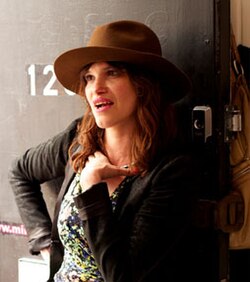Minnie Weisz
Minnie Weisz | |
|---|---|
 Weisz in 2012 | |
| Born | Anna Alexandra Weisz[1] December 1972 (age 51)[2] Westminster, London, England |
| Occupation(s) | Visual artist, photographer |
| Relatives | Rachel Weisz (sister) |
Anna Alexandra "Minnie" Weisz (born December 1972) is an English photographer and visual artist. She specialises in the camera obscura and adapts the technique to turn entire rooms into cameras.
Early life and family[edit]
Weisz was born in London.[3] Her father, George Weisz (1929–2020), was a Hungarian Jewish mechanical engineer. Her mother, Edith Ruth (née Teich; 1932–2016),[4] was a teacher-turned-psychotherapist from Vienna, Austria.[5][6] Her parents left for the United Kingdom around 1938, before the outbreak of the Second World War, to escape the Nazis.[7] Scholar Rev. James Parkes helped her mother and her mother's family leave Austria for England.[8] Her mother's ancestry is Austrian-Jewish, Catholic Viennese and Italian; Weisz's mother formally converted to Judaism upon marrying Weisz's father.[9][10][11]
Weisz's maternal grandfather was Alexander Teich, a Jewish activist who had been a secretary of the World Union of Jewish Students.[12][13][14] Her older sister, Rachel Weisz, is an Academy Award-winning actress.[15]
Career[edit]
Weisz received an MA in Communication Art and Design at the Royal College of Art and a BA in Graphic and Media Design at London College of Printing.[16]
She specialises in the camera obscura and adapts the technique to turn entire rooms into cameras, across Europe. She has described herself (with respect to her artistic activity) as an architectural detective.[17][18][19][20]
Exhibitions[edit]
- King's Cross Stories, exhibition and film, Great Northern Hotel, part of the Arrivals season, King's Cross, London, 14–17 November 2007.[19]
- The Diary of a derelict Dairy, The Express Dairy Depot, Bloomsbury (prior to re-development), 20 June – 20 July 2008, part of the London Festival of Architecture.[21] Weisz curated the exhibition of works upon the subject of buildings and their stories of Bloomsbury.[22]
- Ubi sunt, 2011.[23][24]
Publications[edit]
This article lacks ISBNs for the books listed. (January 2022) |
Editor with Rizzoli International Publications:
- A Picture History of the Grenvilles of Rosedale House by Mary Yelloly. Lyndsey Stainton. Preface by Simon Finch, Helena Bonham-Carter. Designed and edited by Weisz, 2007.
- Narciso Rodriguez by Betsy Berne. Co-edited by Weisz, 2008.
- Norman Parkinson A Very British Glamour by Louise Baring. Designed by Lee Swillingham/Suburbia. Edited by Weisz, 2009.
- Matthew Williamson by Colin McDowell. Edited by Weisz, 2010.
- WKW The Cinema of Wong Kar Wai by John Powers. Co-edited by Weisz, 2016.
References[edit]
- ^ England & Wales, Civil Registration Birth Index, 1916–2007
- ^ "Anna Alexandra WEISZ". Companies House, Government of the United Kingdom. Retrieved 25 February 2019.
- ^ Brown, Mick (1 August 2009). "Rachel Weisz talks about starring in A Streetcar Named Desire". The Daily Telegraph. Archived from the original on 12 November 2012. Retrieved 7 March 2012.
- ^ England and Wales, Death Index, 2007–2017
- ^ "The virtues of Weisz". London Evening Standard. London. 16 November 2006. Archived from the original on 11 November 2013. Retrieved 7 March 2011.
- ^ "Rachel Weisz: 5 things to know about Daniel Craig's new wife". CBS News. Archived from the original on 29 June 2011. Retrieved 7 March 2011.
- ^ Lipworth, Elaine (20 November 2011). "Rachel Weisz: 'I'm still a blushing bride'". The Daily Telegraph. Retrieved 18 June 2012.
- ^ Gugliemi, Jodi (12 October 2016). "How Rachel Weisz's Mother Escaped the Holocaust – and Why It Connected Her to Her Latest Movie Role". People. Retrieved 12 October 2016.
- ^ Brockes, Emma (10 June 2017). "Rachel Weisz: 'My parents were refugees. Brexit feels like a death'". The Guardian. Retrieved 27 June 2018.
- ^ Lane, Harriet (13 June 1999). "Toast of the tomb". The Guardian. London. Archived from the original on 5 May 2010. Retrieved 12 November 2010.
- ^ "Rachel Weisz thinks globally, and Italians win". Sarasota Herald-Tribune. 25 April 2001. pp. 2A. Retrieved 12 November 2010.
- ^ Richmond, Colin; Antony Robin; Jeremy Kushner (2005). Campaigner against anti-Semitism: the Reverend James Parkes, 1896–1981. Vallentine Mitchell. p. 312. ISBN 978-0-85303-573-2.
In the 1970s, Edith Ruth Weisz, the mother of Rachel and Minnie, wrote to Parkes about the rescue of her father, Alexander Teich. Parkes, along with Bentwich, had been responsible for bringing Teich out of imminent danger in Vienna.
- ^ Chertok, Haim (2006). He also spoke as a Jew: the life of James Parkes. Vallentine Mitchell. p. 266. ISBN 0-85303-644-6.
- ^ Parkes, James William (1982). End of an exile: Israel, the Jews, and the Gentile world. Micah Publications. p. 255. ISBN 0-916288-12-9.
- ^ "How I make it work: Minnie Weisz". The Sunday Times. London. 7 February 2010. Retrieved 31 January 2011.
- ^ "Minnie Weisz: I am a camera". The Independent. 28 June 2006. Archived from the original on 15 May 2022. Retrieved 2 December 2021.
- ^ King's Cross Central Ltd Partnership 2010–2011 – Retrieved 3 September 2011
- ^ Greenwood, Phoebe (28 June 2008). "Images of echoes: photographer Minnie Weisz captures King's Cross". The Times. Retrieved 2 December 2021.
- ^ a b Dominic Bradbury, "One last look", The Daily Telegraph, 3 November 2007. Retrieved 2 December 2021
- ^ Dominic Bradbury – Interviews Minnie Weisz – Retrieved 6 January 2012
- ^ ifa2008 (Design by Manha) London festival of architecture.Retrieved 4 September 2011
- ^ NewsDetail. Retrieved 4 September 2011
- ^ (2 August 2011) Last Night: Rituals, Screaming And Lucky Charms Archived 19 October 2011 at the Wayback Machine Andrew Soar (ed.)
- ^ Last Night: Rituals, Screaming And Lucky Charms Archived 11 October 2011 at the Wayback Machine camera obscuras at home, Think Work Play – Retrieved 6 September 2011
